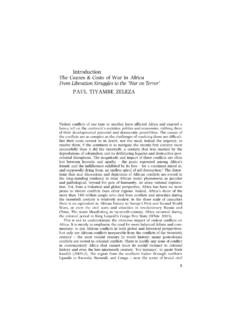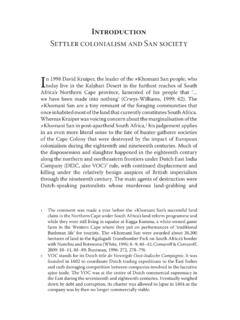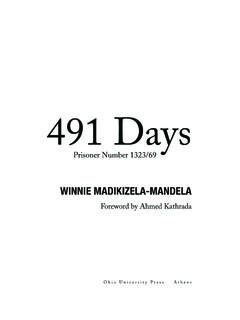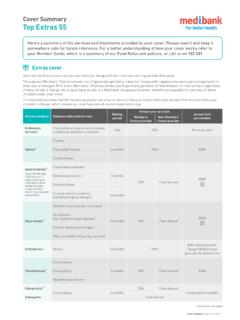Transcription of What Is Environmental Justice? - Ohio University Press
1 1 IntroductionWhat Is EnvironmentalJustice?David A. McDonaldhe history of Environmental policy in South Africa is a crueland perverse one. Under colonial and apartheid governments,thousands of black South Africans were forcibly removed fromtheir ancestral lands to make way for game parks, and billionsof rands were spent on preserving wildlife and protecting wild owerswhile people in townships and homelands 1 lived without adequatefood, shelter, and clean water. Whites-only policies in national parksmeant that black South Africans could not enjoy the country s rich natu-ral heritage, and draconian poaching laws kept the rural poor from des-perately needed resources (Beinart and Coates 1995; Carruthers 1995).
2 In short, ora and fauna were often considered more important than themajority of the country s a result, black South Africans (and anti-apartheid activists ingeneral) paid little attention to Environmental debates during the apart-heid era. At best, the environment was seen to be a white, suburban issueof little relevance to the anti-apartheid struggle. At worst, environmen-tal policy was seen as an explicit tool of racially based the easing of apartheid legislation in the late 1980s and theT2 David A.
3 McDonaldunbanning of anti-apartheid political parties and activists in the early1990s, all of this changed. The liberalization of South African politics cre-ated discursive and institutional space for a rethinking of environmentalissues, and a vibrant debate on the meaning, causes, and effects of envi-ronmental decay began in earnest. Perhaps the most fundamental of thesedevelopments was the simplest: a broadening of the de nition of the environment was rede ned to include the working and livingspace of black South Africans it quickly became apparent that environ-mental initiatives were akin to other post-apartheid, democratic objec-tives.
4 A wide range of trade unions, nongovernmental organizations, civicassociations, and academics quickly adopted the new Environmental dis-course and within a few short years began to challenge the environmentalpractices and policies of the past (Cock and Koch 1991; Ramphele andMcDowell 1991).Central to this new discourse was the concept of environmentaljustice a language that found its rst concrete expression in 1992 at aconference organized by Earthlife Africa, entitled what Does It Mean toBe Green in the New South Africa?
5 (Hallowes 1993). The conferencebrought together leading South African environmentalists and academicswith their counterparts from around the world in an attempt to map outa future for the Environmental justice movement in South Africa. One ofthe outcomes of the conference was the creation of the EnvironmentalJustice Networking Forum (EJNF), a nationwide umbrella organizationdesigned to coordinate the activities of Environmental activists and or-ganizations interested in social and Environmental justice .
6 The networkrapidly expanded to include 150 member organizations by 1995 andwell over 600 member organizations by the election of the African National Congress (ANC) in 1994,the Environmental justice movement had an ally in government as that poverty and Environmental degradation have been closelylinked in South Africa, the ANC made it clear that social, economic,and political relations were also part of the Environmental equation andthat Environmental inequalities and injustices would be addressed as anintegral part of the party s post-apartheid reconstruction and develop-ment mandate (ANC 1994, 38).
7 Indeed, the new South African Constitu-tion, nalized in 1996, includes a Bill of Rights that grants all SouthAfricans the right to an environment that is not harmful to their healthIntroduction: what Is Environmental Justice? 3and well-being and the right to ecologically sustainable development (section 24). Environmental justice in South Africa provides an overview of this rela-tively new Environmental justice movement in South Africa: its historyin the 1990s; where it stands today; and where it might (or should) beheaded in the future.
8 In the same way that the edited collections ofGoing Green (Cock and Koch 1991) and Restoring the Land (Ramphele andMcDowell 1991) captured the changing Environmental tenor of the late1980s and early 1990s, this book attempts to outline the key theoreticaland practical issues facing the Environmental justice movement inSouth Africa ten years on. How have things changed? what has remainedthe same? what are the most (and least) effective strategies for environ-mental activism and how do we conceptualize Environmental justice inSouth Africa in the twenty- rst century?
9 We begin here with a brief discussion of the meaning of environ-mental justice and then move on to discuss the organization and pur-pose of the book in more Environmental JusticeAt its core, Environmental justice is about incorporating environmentalissues into the broader intellectual and institutional framework of humanrights and democratic accountability (Wenz 1988; Bullard 1990; Capek1993; Bryant 1995; Cutter 1995; Goldman 1996; Harvey 1996; Heiman1996; Dobson 1998; Schlosberg 1999; Bowen and Haynes 2000).
10 The termnecessarily encompasses the widest possible de nition of what is considered Environmental and is unrepentantly anthropocentric in its orientation placing people, rather than ora and fauna, at the center of a complex webof social, economic, political, and Environmental relationships. Most im-portant, it concerns itself primarily with the Environmental injustices ofthese relationships, and the ways and means of rectifying these wrongsand/or avoiding them in the future. Locating a toxic waste site next to apoor, black community simply because it is poor and black, for example, isan Environmental injustice that violates basic human rights and demo-cratic accountability and demands remediation and this most basic level, it is easy to see why the environmental4 David A.












